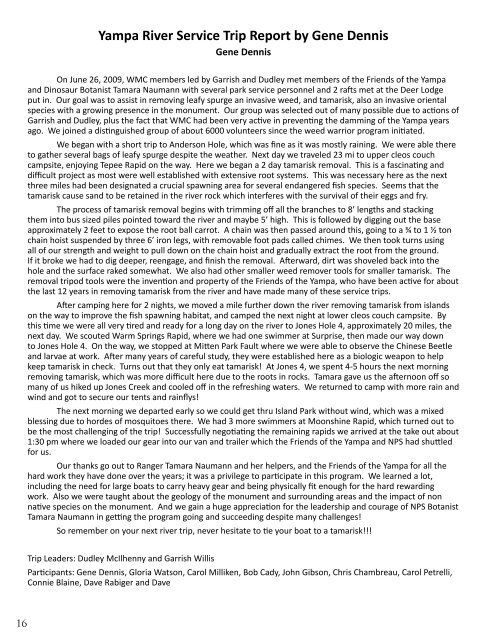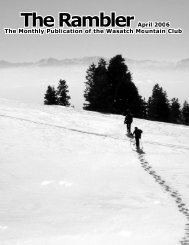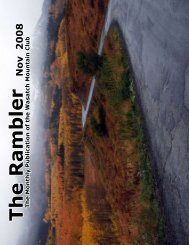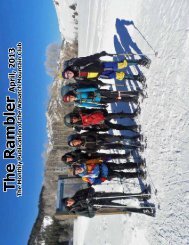Rambler
Aug - Wasatch Mountain Club
Aug - Wasatch Mountain Club
- No tags were found...
You also want an ePaper? Increase the reach of your titles
YUMPU automatically turns print PDFs into web optimized ePapers that Google loves.
Yampa River Service Trip Report by Gene Dennis<br />
Gene Dennis<br />
On June 26, 2009, WMC members led by Garrish and Dudley met members of the Friends of the Yampa<br />
and Dinosaur Botanist Tamara Naumann with several park service personnel and 2 rafts met at the Deer Lodge<br />
put in. Our goal was to assist in removing leafy spurge an invasive weed, and tamarisk, also an invasive oriental<br />
species with a growing presence in the monument. Our group was selected out of many possible due to actions of<br />
Garrish and Dudley, plus the fact that WMC had been very active in preventing the damming of the Yampa years<br />
ago. We joined a distinguished group of about 6000 volunteers since the weed warrior program initiated.<br />
We began with a short trip to Anderson Hole, which was fine as it was mostly raining. We were able there<br />
to gather several bags of leafy spurge despite the weather. Next day we traveled 23 mi to upper cleos couch<br />
campsite, enjoying Tepee Rapid on the way. Here we began a 2 day tamarisk removal. This is a fascinating and<br />
difficult project as most were well established with extensive root systems. This was necessary here as the next<br />
three miles had been designated a crucial spawning area for several endangered fish species. Seems that the<br />
tamarisk cause sand to be retained in the river rock which interferes with the survival of their eggs and fry.<br />
The process of tamarisk removal begins with trimming off all the branches to 8’ lengths and stacking<br />
them into bus sized piles pointed toward the river and maybe 5’ high. This is followed by digging out the base<br />
approximately 2 feet to expose the root ball carrot. A chain was then passed around this, going to a ¾ to 1 ½ ton<br />
chain hoist suspended by three 6’ iron legs, with removable foot pads called chimes. We then took turns using<br />
all of our strength and weight to pull down on the chain hoist and gradually extract the root from the ground.<br />
If it broke we had to dig deeper, reengage, and finish the removal. Afterward, dirt was shoveled back into the<br />
hole and the surface raked somewhat. We also had other smaller weed remover tools for smaller tamarisk. The<br />
removal tripod tools were the invention and property of the Friends of the Yampa, who have been active for about<br />
the last 12 years in removing tamarisk from the river and have made many of these service trips.<br />
After camping here for 2 nights, we moved a mile further down the river removing tamarisk from islands<br />
on the way to improve the fish spawning habitat, and camped the next night at lower cleos couch campsite. By<br />
this time we were all very tired and ready for a long day on the river to Jones Hole 4, approximately 20 miles, the<br />
next day. We scouted Warm Springs Rapid, where we had one swimmer at Surprise, then made our way down<br />
to Jones Hole 4. On the way, we stopped at Mitten Park Fault where we were able to observe the Chinese Beetle<br />
and larvae at work. After many years of careful study, they were established here as a biologic weapon to help<br />
keep tamarisk in check. Turns out that they only eat tamarisk! At Jones 4, we spent 4-5 hours the next morning<br />
removing tamarisk, which was more difficult here due to the roots in rocks. Tamara gave us the afternoon off so<br />
many of us hiked up Jones Creek and cooled off in the refreshing waters. We returned to camp with more rain and<br />
wind and got to secure our tents and rainflys!<br />
The next morning we departed early so we could get thru Island Park without wind, which was a mixed<br />
blessing due to hordes of mosquitoes there. We had 3 more swimmers at Moonshine Rapid, which turned out to<br />
be the most challenging of the trip! Successfully negotiating the remaining rapids we arrived at the take out about<br />
1:30 pm where we loaded our gear into our van and trailer which the Friends of the Yampa and NPS had shuttled<br />
for us.<br />
Our thanks go out to Ranger Tamara Naumann and her helpers, and the Friends of the Yampa for all the<br />
hard work they have done over the years; it was a privilege to participate in this program. We learned a lot,<br />
including the need for large boats to carry heavy gear and being physically fit enough for the hard rewarding<br />
work. Also we were taught about the geology of the monument and surrounding areas and the impact of non<br />
native species on the monument. And we gain a huge appreciation for the leadership and courage of NPS Botanist<br />
Tamara Naumann in getting the program going and succeeding despite many challenges!<br />
So remember on your next river trip, never hesitate to tie your boat to a tamarisk!!!<br />
Trip Leaders: Dudley McIlhenny and Garrish Willis<br />
Participants: Gene Dennis, Gloria Watson, Carol Milliken, Bob Cady, John Gibson, Chris Chambreau, Carol Petrelli,<br />
Connie Blaine, Dave Rabiger and Dave<br />
16
















